Understanding Coat Size Measurements
Understanding coat size measurements is crucial for ensuring the best fit. Accurate chest, waist, and hip measurements help determine the right size, while sleeve length ensures comfort. Always refer to size charts for specific styles, as measurements can vary by brand and design. Proper fit enhances both comfort and appearance.
Importance of Accurate Measurements
Accurate measurements are essential for a perfect coat fit, ensuring comfort and style. Incorrect sizing can lead to discomfort, restricted movement, or an unflattering appearance. Proper measurements help determine the ideal size, avoiding coats that are too tight or too loose. Sleeve length, chest circumference, and hip measurements are critical for functionality and aesthetics. Always measure carefully to ensure the best fit for your body type and desired style.
Key Measurement Points: Chest, Waist, Hips, Sleeve Length
Accurate measurements are vital for a proper fit. The chest is measured around the fullest part, ensuring comfort and mobility. The waist is taken at the narrowest point, while hips are measured at the widest area. Sleeve length is determined from the shoulder to the cuff. These key points ensure the coat fits well, providing comfort and a flattering silhouette. Proper measurements guarantee the best fit for your body type and style preferences.
How to Use a Size Chart Effectively
Using a size chart effectively involves comparing your measurements to the chart. Measure your chest, waist, hips, and sleeve length accurately. Match these to the chart’s corresponding sizes. Consider the fit type (slim, regular, oversized) and fabric thickness. Check for ease of movement and comfort. Ensure the coat aligns with your body type and style preferences for a flattering and functional fit.
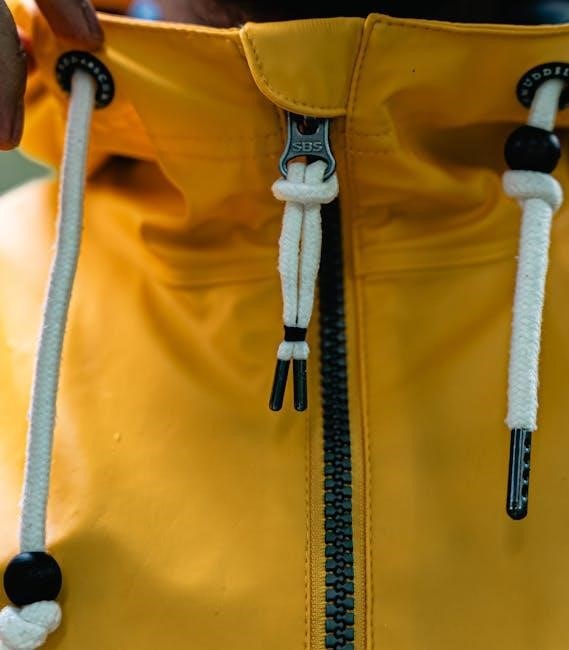
Standard Coat Size Charts
Standard coat size charts provide measurements for chest, waist, hips, and sleeve length across sizes like XS to XXXL. They vary by region and brand, ensuring accurate fit.
Men’s Coat Size Guide
Men’s coat sizes typically range from XS to XXL, based on chest circumference. Measurements vary by brand, but common sizes include: XS (83-88cm), S (89-93cm), M (94-100cm), L (101-105cm), XL (106-112cm), and XXL (113-117cm). To ensure accuracy, measure around the fullest part of the chest. Consider layering needs for a comfortable fit, as some styles may require sizing up for proper comfort and mobility.
Women’s Coat Size Guide
Women’s coat sizes range from XXS to 3XL, based on chest, waist, and hip measurements. Common sizes include: XXS (80cm chest), XS (84cm), S (88cm), M (92cm), L (96cm), XL (100cm), and 2XL (104cm). Use a flexible tape measure around the fullest part of the bust, keeping the tape level. Consider the style and fabric thickness when choosing your size for optimal comfort and fit.
Unisex and Universal Sizing
Unisex coats offer a versatile fit, catering to a broad range of body types. Sizes typically range from XS to 3XL, with measurements based on chest circumference. For example, XS fits 80-86cm, S fits 86-92cm, M fits 92-98cm, L fits 98-104cm, XL fits 104-110cm, and 2XL fits 110-116cm. Universal sizing ensures comfort and adaptability, making it ideal for layering or diverse styling needs while maintaining a balanced, gender-neutral fit.
How to Measure Yourself for a Coat
Use a flexible tape measure to determine chest, waist, hips, and sleeve length. Ensure the tape is level and not too tight for accurate sizing.
Measuring Chest Circumference
To measure chest circumference, wrap a flexible tape measure around the fullest part of your chest, keeping it level and parallel to the floor. Ensure the tape isn’t too tight or loose. This measurement is crucial for determining your coat size, as it directly impacts the fit across the shoulders and torso. Accurate chest measurement ensures comfort and proper drape of the coat.
Measuring Sleeve Length
To measure sleeve length, start at the center back of your neck, just below the base of the skull. Measure over the shoulder, down to the wrist with your arm slightly bent. This ensures the sleeve fits comfortably without being too long or short. Accurate sleeve length is essential for both style and functionality, preventing restrictive or overly loose fit.
Measuring Waist and Hips
To measure your waist, find the narrowest point of your torso, typically just above the belly button. For hips, measure around the fullest part, usually 7-9 inches below your waistline. Stand naturally with feet shoulder-width apart and use a flexible tape measure. Ensure the tape is level and not too tight for accurate readings. These measurements are crucial for determining the best coat fit and comfort.

Factors Affecting Coat Fit
Body type, fabric thickness, and seasonal variations influence coat fit. Slim builds prefer tailored styles, while broader frames may need roomier designs. Layering and fabric weight also impact size choice.
Body Type and Coat Style
Body type significantly impacts coat fit. Petite individuals should opt for shorter, tailored coats to avoid overwhelming their frame. Tall individuals benefit from longer coats that balance proportions. Plus-size bodies look best in structured, A-line styles or coats with defined waistlines. Slim builds can wear oversized designs or fitted coats, depending on desired aesthetics. Matching coat style to body type ensures a flattering and comfortable fit.
Fabric Thickness and Layering
Fabric thickness and layering significantly impact coat fit. Thicker fabrics, like wool or down-filled coats, may require sizing up for comfort. Layering underneath can also affect fit, potentially necessitating a larger size. Always consider the coat’s material and intended use when choosing a size, as some styles are designed to accommodate bulky layers. Check size guides for specific fabric types to ensure optimal comfort and mobility.
Seasonal Variations in Sizing
Seasonal variations can influence coat sizing due to differences in fabric weight and layering needs. Winter coats may require a larger size to accommodate thicker layers, while summer coats might fit more snugly. Always check the size chart for the specific season and fabric type, as some brands adjust sizing to account for these variations. Proper fit ensures comfort and functionality across seasons.
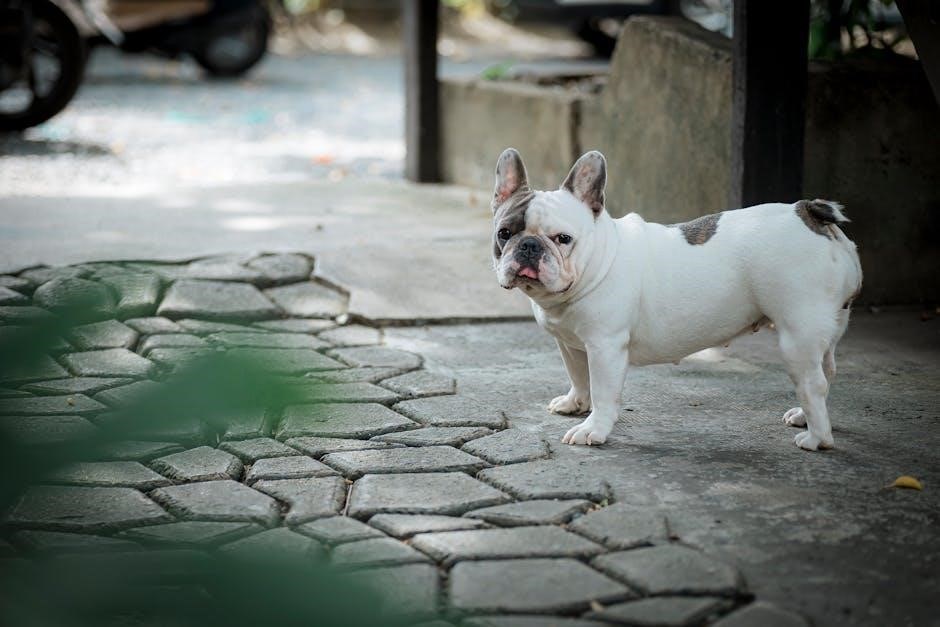
International Size Conversion
International size conversion charts help bridge regional sizing differences, ensuring a consistent fit across US, EU, and UK sizes. They simplify choosing the correct size globally.
US to EU Size Conversion
Understanding the US to EU size conversion is essential for international shopping. US sizes typically range from XXS to XXXL, while EU sizes use numerical measurements. For example, a US XS corresponds to an EU 34-36, and a US XL aligns with an EU 46-48. Refer to specific size charts for accurate conversions, as measurements may vary slightly by brand and style. This ensures a perfect fit and avoids sizing mismatches.
UK to US Size Conversion
When converting UK to US sizes, it’s important to align measurements accurately. For example, a UK size 8-10 corresponds to a US XS-S, while a UK 12-14 matches a US M-L. Specific size charts may vary slightly by brand, so always check the brand’s guide for precise conversions. This ensures a seamless fit when shopping across international brands and avoids sizing discrepancies.
Understanding Size Labels
Understanding size labels is essential for selecting the right coat. Labels like S, M, L, XL correspond to standard measurements, but variations exist across brands. For example, a UK size 10-12 may align with a US M or EU 38-40. Always refer to the brand’s size chart, as labels can differ slightly. This ensures a proper fit and avoids sizing mismatches when shopping across different brands or regions.
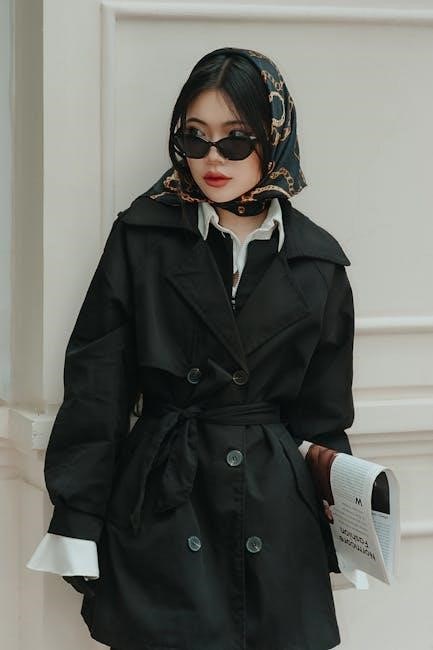
Popular Coat Styles and Sizing Tips
Popular coat styles include trench coats, overcoats, pea coats, parkas, and down coats. Each style fits differently, so sizing tips vary. Trench coats are often fitted, while parkas may require sizing up for layering. Always consider fabric thickness and intended use when choosing your size.
Trench Coats
Trench coats are a timeless choice, offering a sleek, double-breasted design with a belted waist. For optimal fit, measure your chest and consider layering needs. If layering thick sweaters, size up for comfort. The belted waist allows adjustments, but ensure shoulders fit snugly. Petite individuals may prefer shorter trench coats, while taller people can opt for longer styles to balance proportions. Always check the brand-specific size chart for accurate sizing, ensuring a tailored appearance.
Overcoat and Pea Coats
Overcoats are designed to be worn over other clothing, so measure your chest and shoulders to ensure a comfortable fit. Opt for a size that allows layering without feeling restrictive. Pea coats are shorter and more fitted, emphasizing a tailored look. Measure your chest and waist to find the perfect balance between style and comfort. Always refer to the brand’s size chart for precise sizing.
Parkas and Down Coats
Parkas and down coats are designed for warmth and durability, often featuring adjustable hoods and hemlines. When sizing, consider your chest measurement and layering needs, as these coats are typically worn over thicker clothing. Fit can vary by brand, so refer to the size chart for accurate measurements. Adjustable cuffs and drawstrings allow for a customized fit, while longer lengths provide extra coverage. Ensure the coat’s style suits your body type and activity level for optimal comfort and functionality.
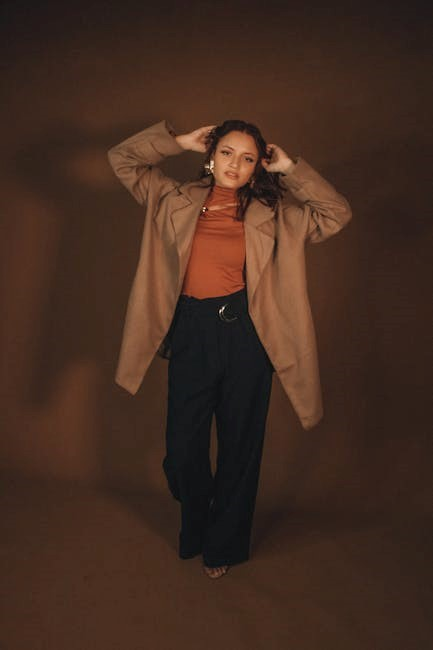
Specialized Sizing Needs
Specialized sizing caters to diverse needs, including kids’, plus-size, and petite or tall individuals. Accurate measurements ensure proper fit, while size charts help address unique requirements for comfort and style.
Kids’ Coat Sizing
Kids’ coat sizing varies by age and body proportions. For ages 2-3, coats are 55cm long, 42cm wide, with 37cm sleeves. Ages 3-5 require 72cm length, 42cm width, and 37cm sleeves. Proper fit ensures comfort and warmth. Measure chest, waist, and sleeve length accurately. Check size charts for specific age groups and styles to avoid ill-fitting coats that may be removed in cold weather due to discomfort.
Plus-Size and Curve-Friendly Coats
Plus-size and curve-friendly coats are designed to flatter diverse body types. Look for brands like Henning, Universal Standard, and Eloquii, which cater to plus-size needs. Measure chest, waist, and hips to ensure a comfortable fit. Styles with adjustable belts or A-line cuts can enhance proportions. Always check size charts, as sizing varies by brand. Proper fit ensures both style and comfort for curvier figures.
Petite and Tall Sizing
Petite and tall sizing ensures coats fit proportions for shorter or taller frames. Petite coats feature shorter sleeve and coat lengths, while tall sizes offer extended lengths. Measure chest, sleeve, and coat length for accuracy. Check size charts for specific petite or tall ranges, as sizing varies by brand. Look for styles designed for your height to ensure a flattering, comfortable fit.
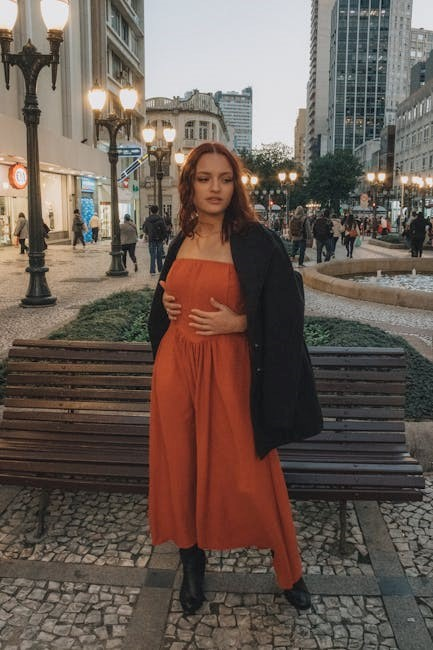
Custom and Oversized Coats
Custom coats are tailored to individual measurements, ensuring a perfect fit. Oversized styles offer a loose, trendy look. Check size charts for accurate sizing, as measurements vary by brand. Consider fabric thickness and desired fit when choosing oversized or custom options for optimal comfort and style.
How to Choose the Right Oversized Fit
Choosing the right oversized fit involves balancing comfort and style. Compare your measurements to size charts, ensuring ease of movement. Consider your body type—looser fits flatter petite frames, while structured oversized coats suit taller individuals. Check fabric thickness, as heavier materials may require a slightly smaller size. Review brand-specific guides, as sizing can vary. Aim for a fit that feels relaxed but not overwhelming, ensuring the coat drapes well on your frame.
Custom Tailoring Options
Custom tailoring offers a personalized fit, ensuring your coat matches your unique measurements and style preferences. Tailors take precise measurements, including chest, waist, hips, and sleeve length, to craft a coat that flatters your body type. Choose fabrics, colors, and details like buttons or linings. This option is ideal for those seeking a bespoke look or addressing specific fit challenges. Consult with professionals to achieve a flawless, tailored design.
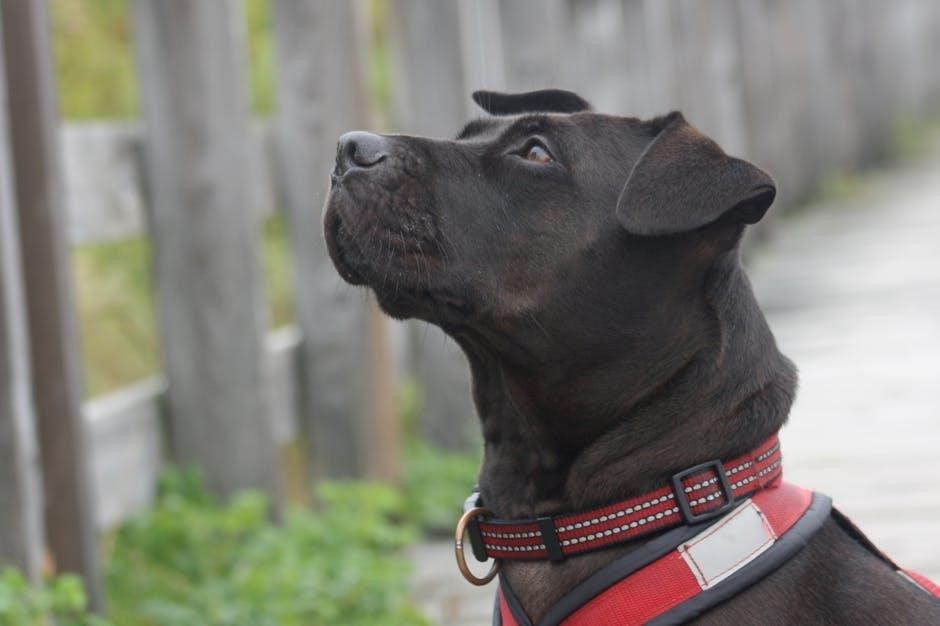
Accessories and Additional Features
Coats often come with accessories like hoods, pockets, and adjustable cuffs for functionality. Features such as zippers, buttons, and insulation enhance comfort and style. These details ensure versatility.
Hoods, Sleeves, and Pockets
Hoods provide protection from elements, while sleeves vary in length for comfort. Pockets offer practical storage, with side pockets being common. Adjustable cuffs and insulation enhance functionality; Size guides often detail sleeve lengths and pocket placements, ensuring the coat fits well. Consider these features for optimal comfort and style, as they vary by brand and design.
Zippers and Buttons
Zippers and buttons are essential for coat closure and functionality. Two-way zippers offer versatility, while high-quality buttons ensure durability. Their placement and design can impact fit and comfort. Always check the size guide for details on closure systems, as they vary by style. Proper alignment of zippers and buttons ensures a secure and comfortable fit, enhancing the overall wearability of the coat.
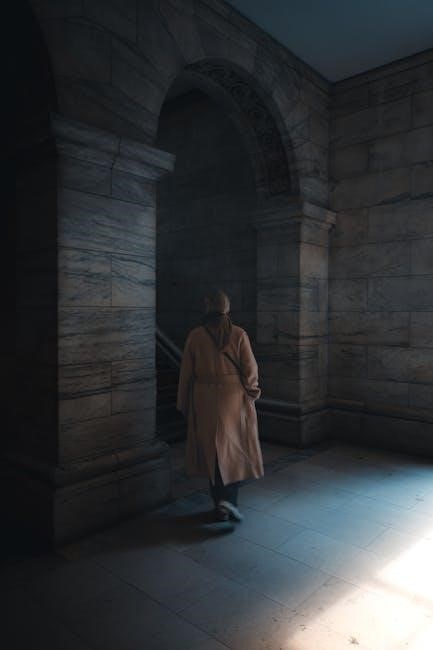
Care and Maintenance Tips
Proper care extends the life of your coat. Clean according to fabric type, avoid harsh chemicals, and store in a cool, dry place. Follow care labels.
How to Clean and Store Coats
Cleaning and storing coats properly ensures longevity. Check fabric care labels for specific instructions. For wool coats, brush gently to remove dirt. Down coats can be hand-washed or dry-cleaned. Store coats in breathable bags or on hangers to avoid creases. Avoid direct sunlight to prevent fading. Use moth repellents for long-term storage. Regular maintenance keeps coats looking their best season after season.
Extending the Life of Your Coat
To extend the life of your coat, regular maintenance is essential. Brush wool coats to remove dirt and prevent pilling. For down-filled coats, fluff the filling after washing to restore loft. Use a fabric protector to repel stains and water. Store coats on wide hangers or in breathable bags to maintain shape. Avoid over-dry cleaning, as it can damage materials. Proper care ensures your coat remains durable and stylish for years.

Brands and Their Sizing
Brands often have unique sizing standards. ASOS and Frank and Oak offer detailed size charts for accurate fits. Always check brand-specific guides for the best sizing.
Popular Brands and Their Fit
Popular brands like ASOS, Frank and Oak, and Didriksons offer detailed size charts for accurate fits. ASOS provides chest, waist, and hip measurements, while Frank and Oak focuses on tailored fits. Brands like Henning and Universal Standard cater to plus-size and curve-friendly options. Always check brand-specific guides, as sizing can vary. Measure yourself and refer to customer reviews for the best fit.
Reading Brand-Specific Size Guides
Reading brand-specific size guides is essential for a precise fit. Each brand may have unique measurements, so always review their charts. Look for chest, waist, and hip measurements, as well as sleeve lengths. Pay attention to fabric type and fit descriptions, like “tailored” or “oversized.” Use customer reviews for insights and double-check your own measurements against the guide for accuracy. This ensures the best fit for your chosen style.
Choosing the right coat size ensures comfort and style. Use brand-specific guides, measure accurately, and consider fabric thickness. Proper fit boosts confidence and satisfaction.
Final Tips for Choosing the Perfect Coat
Always use a size chart specific to the brand and style for accurate fitting. Consider fabric thickness and layering needs; Ensure sleeve length and body measurements align with your body type. Try the coat on if possible, or check reviews for fit feedback. Double-check chest, waist, and hip measurements for the best comfort and appearance.

